Kenwood KDC-MP919, KDC-X859, KDC-X759 User Manual
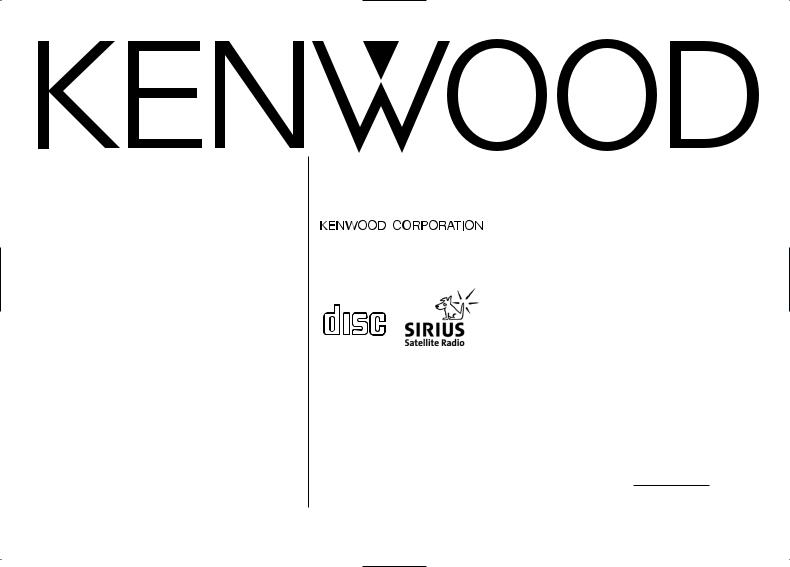
KDC-X859 KDC-MP919 KDC-X759
CD-RECEIVER
INSTRUCTION MANUAL
COMPACT
DIGITAL AUDIO
Take the time to read through this instruction manual.
Familiarity with installation and operation procedures will help you obtain the best performance from your new CD-receiver.
For your records
Record the serial number, found on the back of the unit, in the spaces designated on the warranty card, and in the space provided below. Refer to the model and serial numbers whenever you call upon your KENWOOD dealer for information or service on the product.
Model KDC-X859, KDC-MP919, KDC-X759 Serial number
© B64-2215-00 (KW)
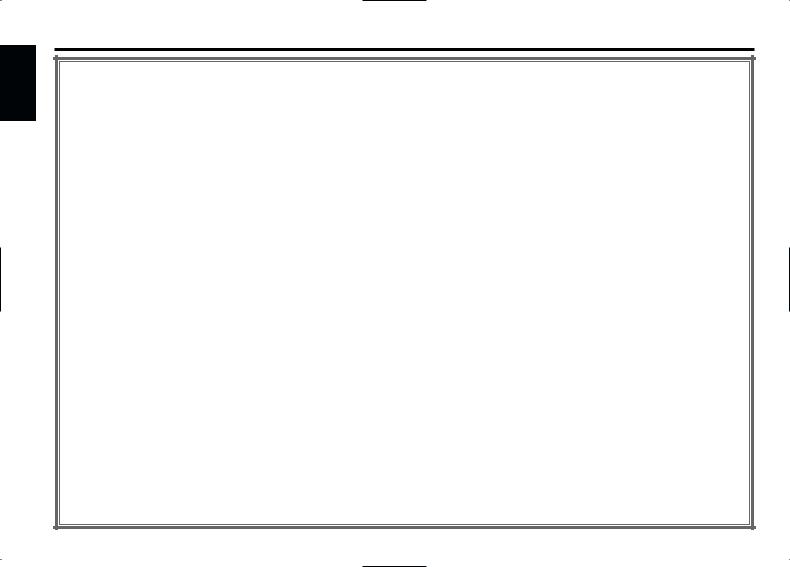
English
Contents
Safety precautions...................... |
4 |
About RDS .................................. |
5 |
Notes on playing MP3 ................ |
6 |
About CDs................................... |
8 |
General features ......................... |
9 |
Power
Selecting the Source
Volume
System Q
Audio Control
Speaker & Woofer Setting
Switching Full Screen Display
Switching the Standby Display
Switching Upper and Lower Part Display
Station/Disc Naming (SNPS/DNPS)
Non-fading Output
Faceplate Angle Adjustment
Theft Deterrent Faceplate
Hiding the Control Panel
Tuner features |
...........................18 |
Tuning Mode
Tuning
Direct Access Tuning
Station Preset Memory
Auto Memory Entry
Preset Tuning
SNPP (Station Name Preset Play)
RDS features............................. |
21 |
Radio Text Scroll |
|
PTY (Program Type) |
|
Program Type preset |
|
Registration of a station as a PTY |
|
CD/MP3/External disc control |
|
features .................................. |
24 |
Playing CD & MP3 |
|
Playing External Disc |
|
Fast Forwarding and Reversing |
|
Track Search |
|
Album Search |
|
Direct Track Search |
|
Direct Album Search |
|
Track Repeat |
|
Album Repeat |
|
Track/Album Repeat |
|
Track Scan |
|
Random Play |
|
Magazine Random Play |
|
Album Select |
|
Text/Title Scroll |
|
DNPP (Disc Name Preset Play) |
|
Menu system............................. |
28 |
Menu System |
|
Security Code |
|
Touch Sensor Tone |
|
Manual Clock Adjustment |
|
Date Adjustment |
|
Date Mode |
|
Synchronize Clock |
|
Selectable Illumination
Switching Display Type
Switching Upper and Lower Part Display Icon/Spectrum analyzer Select
Font Type Select
Font Color Select Dimmer
OFF Wait Time Setting System Q
Built-in Amp Mute Setting Dual Zone System
B.M.S. (Bass Management System) B.M.S. Frequency Offset
Auto Memory Entry
Traffic Information
CRSC (Clean Reception System Circuit) Auxiliary Input Display Setting &
Station/Disc Naming Text Scroll
Basic Operations of remote...... |
36 |
Accessories............................... |
38 |
Installation Procedure .............. |
38 |
Connecting Wires |
|
Terminals................................ |
39 |
Installation ................................ |
40 |
Removing the Unit.................... |
41 |
Locking the faceplate |
|
to the unit .............................. |
41 |
Troubleshooting Guide ............. |
42 |
Specifications ........................... |
46 |
— 2 —
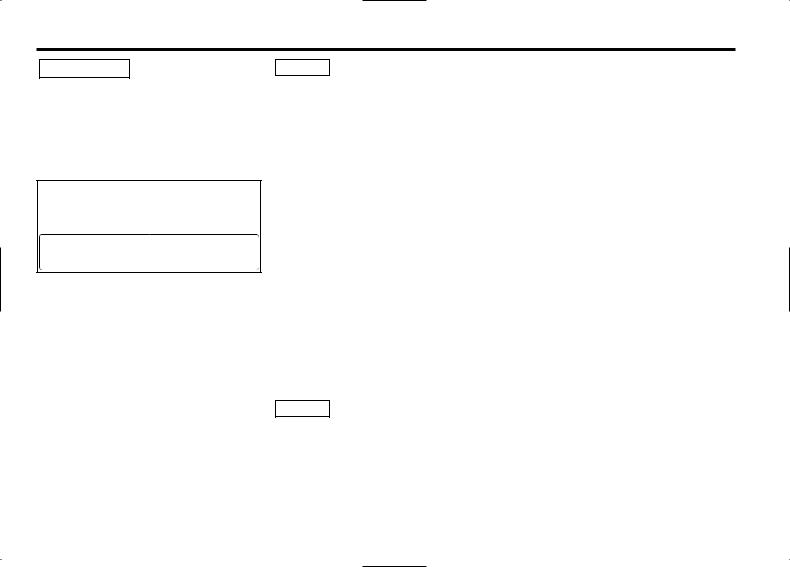
2Warning
2CAUTION
Use of controls or adjustments or performance of procedures other than those specified herein may result in hazardous radiation exposure.
In compliance with Federal Regulations, following are reproductions of labels on, or inside the product relating to laser product safety.
KENWOOD CORPORATION 2967-3, ISHIKAWA-CHO, HACHIOJI-SHI
TOKYO, JAPAN
KENWOOD CORP. CERTIFIES THIS EQUIPMENT CONFORMS TO DHHS REGULATIONS N0.21 CFR 1040. 10, CHAPTER 1, SUBCHAPTER J.
Location : Bottom Panel
FCC WARNING
This equipment may generate or use radio frequency energy. Changes or modifications to this equipment may cause harmful interference unless the modifications are expressly approved in the instruction manual. The user could lose the authority to operate this equipment if an unauthorized change or modification is made.
NOTE
This equipment has been tested and found to comply with the limits for a Class B digital device, pursuant to Part 15 of the FCC Rules. These limits are designed to provide reasonable protection against harmful interference in a residential installation. This equipment may cause harmful interference to radio communications, if it is not installed and used in accordance with the instructions. However, there is no guarantee that interference will not occur in a particular installation. If this equipment does cause harmful interference to radio or television reception, which can be determined by turning the equipment off and on, the user is encouraged to try to correct the interference by one or more of the following measures:
•Reorient or relocate the receiving antenna.
•Increase the separation between the equipment and receiver.
•Connect the equipment into an outlet on a circuit different from that to which the receiver is connected.
•Consult the dealer or an experienced radio/TV technician for help.
NOTE
This Class B digital apparatus complies with Canadian ICES-003.
— 3 —
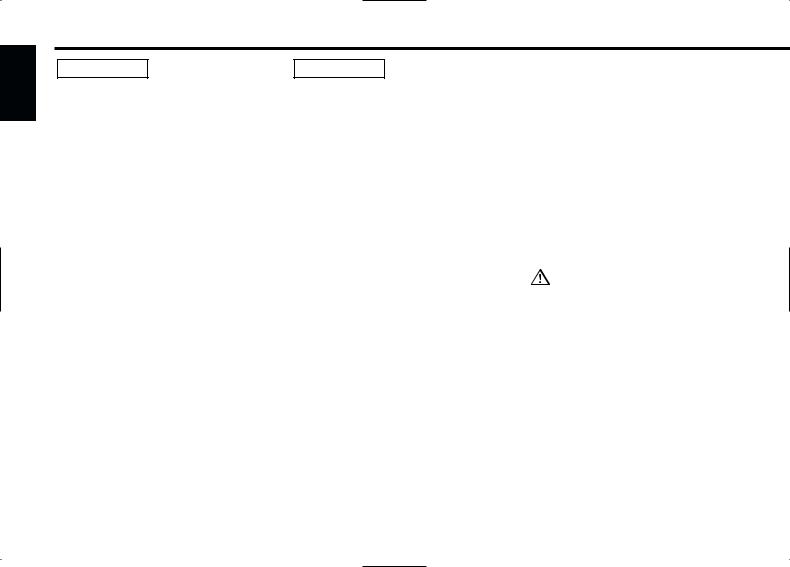
English
Safety precautions
2WARNING |
2CAUTION |
To prevent injury or fire, take the following precautions:
•Insert the unit all the way in until it is fully locked in place. Otherwise it may fall out of place when jolted.
•When extending the ignition, battery, or ground wires, make sure to use automotivegrade wires or other wires with a 0.75mm2 (AWG18) or more to prevent wire deterioration and damage to the wire coating.
•To prevent a short circuit, never put or leave any metallic objects (such as coins or metal tools) inside the unit.
•If the unit starts to emit smoke or strange smells, turn off the power immediately and consult your Kenwood dealer.
•Make sure not to get your fingers caught between the faceplate and the unit.
•Be careful not to drop the unit or subject it to strong shock.
The unit may break or crack because it contains glass parts.
To prevent damage to the machine, take the following precautions:
•Make sure to ground the unit to a negative 12V DC power supply.
•Do not open the top or bottom covers of the unit.
•Do not install the unit in a spot exposed to direct sunlight or excessive heat or humidity. Also avoid places with too much dust or the possibility of water splashing.
•Do not subject the faceplate to excessive shock, as it is a piece of precision equipment.
•When replacing a fuse, only use a new one with the prescribed rating. Using a fuse with the wrong rating may cause your unit to malfunction.
•To prevent a short circuit when replacing a fuse, first disconnect the wiring harness.
•Do not place any object between the faceplate and the unit.
•Do not use your own screws. Use only the screws provided. If you use the wrong screws, you could damage the unit.
•Do not apply excessive force to the moving faceplate. Doing so will cause damage or malfunction.
•Do not apply excessive force to the open faceplate or place objects on it. Doing so will cause damage or breakdown.
IMPORTANT INFORMATION
About the disc changer/CD player to be connected:
To connect a disc changer having the "O-N" switch to this unit, set the "O-N" switch to "N". When you connect a model with no "O-N" switch, the converter cord CA-DS100 available as an option may be required. For details, consult your Kenwood dealer.
A disc changer doesn't work when it is connected without using these options.
If a model with no "O-N" switch is connected, some unavailable functions and information that cannot be displayed are generated. Note that none of the KDC-C100, KDC-C302, C205, C705, and non-Kenwood CD changers can be connected.
You can damage both your unit and the CD changer if you connect them incorrectly.
Do Not Load 3-in. CDs in the CD slot
If you try to load a 3 in. CD with its adapter into the unit, the adapter might separate from the CD and damage the unit.
— 4 —
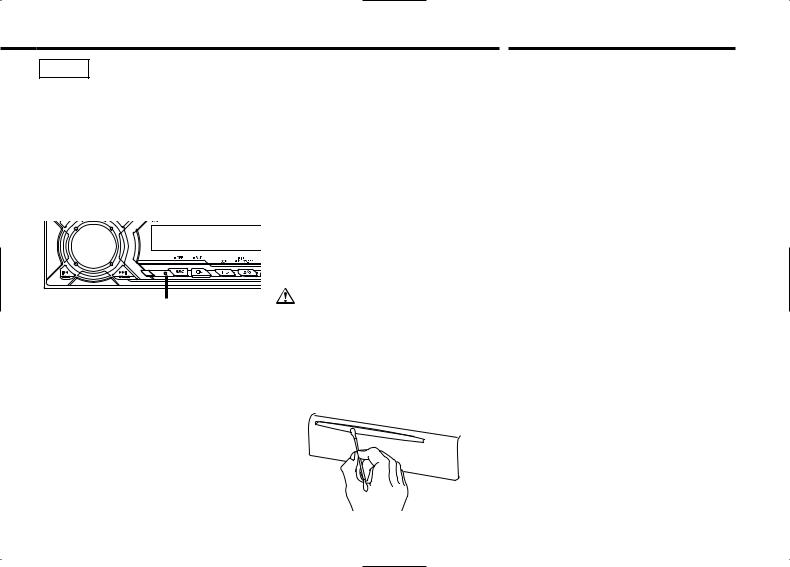
NOTE
•If you experience problems during installation, consult your Kenwood dealer.
•If the unit fails to operate properly, press the Reset button. The unit returns to factory settings when the Reset button is pressed. If the unit still fails to operate properly after the Reset button has been pressed, contact your local KENWOOD dealer for assistance.
•Press the reset button if the disc auto changer fails to operate correctly. Normal operation should be restored.
Lens Fogging
Right after you turn on the car heater in cold weather, dew or condensation may form on the lens in the CD player of the unit. Called lens fogging, CDs may be impossible to play. In such a situation, remove the disc and wait for the condensation to evaporate. If the unit still does not operate normally after a while, consult your Kenwood dealer.
Cleaning the Faceplate Terminals
If the terminals on the unit or faceplate get dirty, wipe them with a dry, soft cloth.
Cleaning the Unit
If the faceplate of this unit is stained, wipe it with a dry soft cloth such as a silicon cloth.
If the faceplate is stained badly, wipe the stain off with a cloth moistened with neutral cleaner, then wipe neutral detergent off.
Reset button
•We recommend the use of the Security Code function (see p. 30) to prevent theft.
•The illustrations of the display and the panel appearing in this manual are examples used to explain more clearly how the controls are used. Therefore, what appears on the display in the illustrations may differ from what appears on the display on the actual equipment, and some of the illustrations on the display may represent something impossible in actual operation.
Applying spray cleaner directly to the unit may affect its mechanical parts. Wiping the
faceplate with a hard cloth or using a volatile liquid such as thinner or alcohol may scratch the surface or erases characters.
Cleaning the CD Slot
As dust tends to accumulate in the CD slot, clean it every once in a while. Your CDs can get scratched if you put them in a dusty CD slot.
About RDS (KDC-X859)
RDS (Radio Data System)
RDS is a service used by radio stations to transmit data outside normal radio broadcast signals.
When an RDS station is received, you can immediately find out what kind of data is being transmitted by looking at the program service name, which appears in the display after the frequency.
The RDS indicator turns on when an RDS station is being received.
Alarm
When an emergency transmission (announcing disasters, etc.) is made, the current function will be interrupted to allow the warning to be received under the following conditions: during tuner reception, or when the Traffic Information function is turned on.
— 5 —

English
Notes on playing MP3(KDC-X859/ MP919)
This unit can play MP3(MPEG1, 2, 2.5 Audio Layer 3). Note, however, that the MP3 recording media and formats acceptable are limited. When writing MP3, pay attention to the following restrictions.
Acceptable media
The MP3 recording media acceptable to this unit are CD-ROM, CD-R, and CD-RW.
When using CD-RW, do full format not quick format to prevent malfunction.
Acceptable medium formats
The following formats are available for the media used in this unit. The maximum number of characters used for file name including the delimiter (".") and three-character extension are indicated in parentheses.
•ISO 9660 Level 1 (12 characters)
•ISO 9660 Level 2 (31 characters)
•Joliet (64 characters)
•Romeo (128 characters)
Up to 200 characters can be displayed in the long file name format. For a list of available characters, see the instruction manual of the writing software and the section Entering file and folder names below. The media reproducible on this unit has the following limitations:
•Maximum number of directory levels: 8
•Maximum number of files per folder: 255
•Maximum number of characters for folder name: 64
•Maximum number of folders: 50
MP3 written in the formats other than the above may not be successfully played and their file names or folder names are not properly displayed.
Settings for your MP3 encoder and CD writer
When you use your CD writer to record MP3 up to the maximum disc capacity, disable additional writing. For recording on an empty disc up to the maximum capacity at once, check Disc at Once.
Entering ID3 tag
The Displayable ID3 tag is ID3 version 1.x.
For the character code, refer to the List of Codes.
Entering file and folder names
The code list characters are the only  file names and folder names that can
file names and folder names that can  be entered and displayed.
be entered and displayed.  If you use any other character for
If you use any other character for  entry, the file and folder names are not displayed correctly. They may neither be displayed correctly depending on the CD writer used.
entry, the file and folder names are not displayed correctly. They may neither be displayed correctly depending on the CD writer used.
The unit recognizes and plays only those MP3 which have the MP3 extension (.MP3).
A file with a name entered with characters not on the code list may not play correctly.
Writing files into a medium
When a medium containing MP3 data is loaded, the unit checks all the data on the medium. If the medium contains a lot of folders or nonMP3 files, therefore, it takes a long time until the unit starts playing MP3.
In addition, it may take time for the unit to move to the next MP3 file or a Track Search or Album Search may not be performed smoothly.
Loading such a medium may produce loud noise to damage the speakers.
• Do no attempt to play a medium containing a non-MP3 file with the MP3 extension.
The unit mistakes non-MP3 files for MP3 data as long as they have the MP3 extension.
• Do not attempt to play a medium containing non MP3.
— 6 —
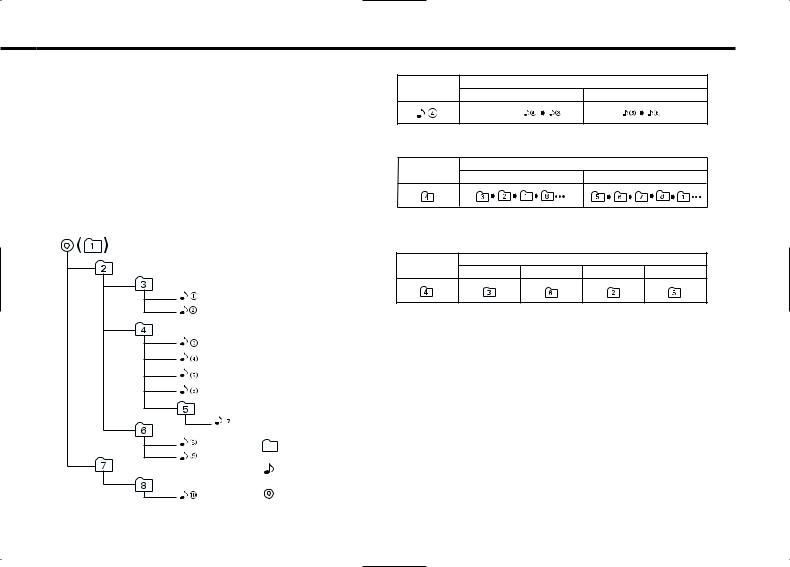
MP3 playing order
When selected for play, Album Search, Track Search, or for Album Select, files and folders are accessed in the order in which they were written by the CD writer.
Because of this, the order in which they are expected to be played may not match the order in which they are actually played. You may be able to set the order in which MP3 are to be played by writing them onto a medium such as a CD-R with their file names beginning with play sequence numbers such as "01" to "99", depending on your CD writer.
For example, a medium with the following folder/ file hierarchy is subject to Album Search, Track Search, or Album Select as shown below.
Example of a medium's folder/file hierarchy
When a Track Search is executed with file ¡$ being played ...
Current |
|
Operation of the button |
file number |
4 Button |
¢ Button |
|
Beginning of file |
|
When an Album Search is executed with file ¡$ being played ...
Current |
Operation of the button |
|
|
|
|
folder number |
AM Button |
FM Button |
When Album Select is selected with file ¡$ being played to move
from folder to folder ...
Current |
|
Operation of the button |
|
|
|
|
|
|
|
folder number |
4 Button |
¢ Button |
AM Button |
FM Button |
Folder
File
Root
Level 1 |
Level 3 |
Level 2 |
Level 4 |
— 7 —
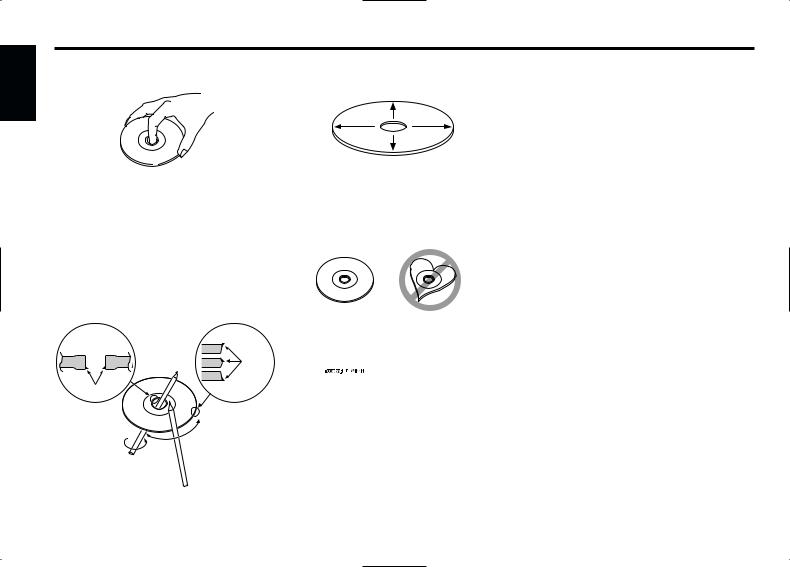
English
About CDs
Handling CDs
• Don’t touch the recording surface of the CD.
•CD-R and CD-RW are easier to damage than a normal music CD. Use a CD-R or a CD-RW after reading the caution items on the package etc.
•Don’t stick tape etc. on the CD.
Also, don’t use a CD with tape stuck on it.
When using a new CD
If the CD center hole or outside rim has burrs, use it after removing them with a ball pen etc.
Burrs
Burrs
CD accessories
Don’t use disc type accessories.
CD cleaning
Clean from the center of the disc and move outward.
Removing CDs
When removing CDs from this unit pull them out horizontally.
CDs that can’t be used
• CDs that aren’t round can’t be used.
•CDs with coloring on the recording surface or that are dirty can’t be used.
•Don’t use CDs without disc mark


 .
.
•A CD-R or CD-RW that hasn’t been finalized can’t be played. (For the finalization process refer to your CD-R/CD-RW writing software, and your CD-R/CD-RW recorder instruction manual.)
CD storage
•Don’t place them in direct sunlight (On the seat or dashboard etc.) and where the temperature is high.
•Store CDs in their cases.
—8 —
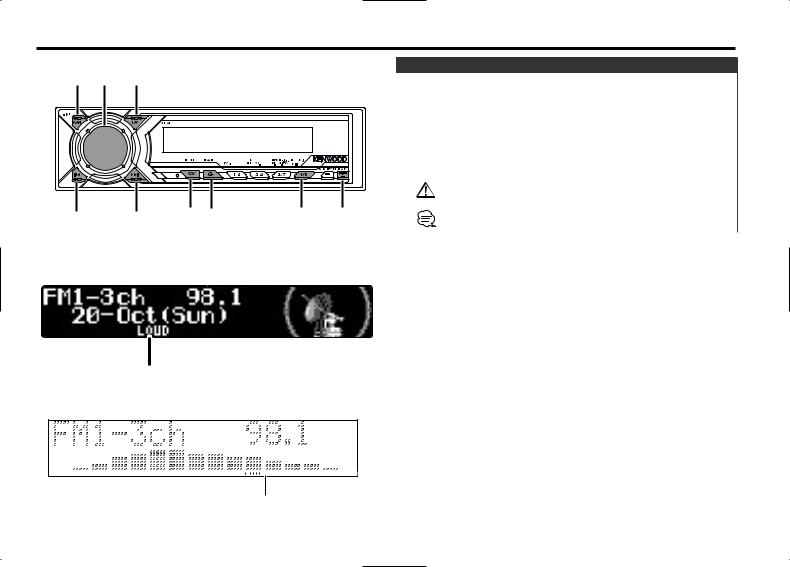
General features
AM/ |
|
Power |
VOL FM |
|
|
NF |
Turning ON the Power |
|
|
|
Turn the vehicle ignition ON.
The faceplate reverses and control panel is displayed.
Turing OFF the Power
Turn the vehicle ignition OFF.
When the set time for removing the faceplate (page 17) lapses, the faceplate reverses and the control panel is hidden.
Do not apply force to the faceplate during operation. It can cause damage.
4 |
¢ |
SRC Q/ |
MENU |
ANG |
When the power is ON, the <Security Code> (page 30) is displayed |
AUD |
as "CODE ON" or "CODE OFF". |
|
KDC-MP919/ KDC-X759
LOUD indicator
KDC-X859
IN |
SQ |
ATT |
ST |
LOUD |
RDS |
TI |
LOUD indicator
— 9 —
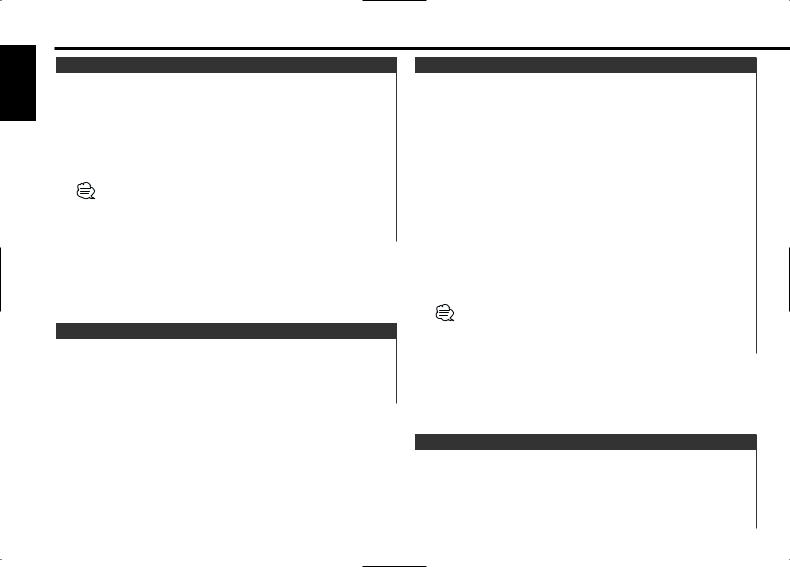
English
General features
Selecting the Source
Press the [SRC] button. |
|
Source required |
Display |
Tuner |
"TUNER" |
CD |
"COMPACT DISC"/"CD" |
External disc |
"DISC-CH"/"DISC" |
Auxiliary input |
"AUX" |
Standby (Illumination only mode) |
"ALL OFF" |
For Auxiliary input one of the below optional accessories is necessary.
-KCA-S210A
-CA-C1AX
-CD changer with an Auxiliary input function installed.
Volume
Increasing Volume
Turn the [VOL] knob clockwise.
Decreasing Volume
Turn the [VOL] knob counterclockwise.
System Q
You can recall the best sound setting preset for different types of the music.
1Select the source to set
Press the [SRC] button.
2Select the Sound type
Press the [Q] button.
Each time the button is pressed the sound setting switches.
Sound setting |
Display |
Flat |
"FLAT" |
User memory |
"User Preset" |
Rock |
"ROCK" |
Pops |
"POPS" |
Easy |
"EASY" |
Top 40 |
"TOP 40" |
Jazz |
"JAZZ" |
•User memory: The values set on the <Audio control> (page 10).
•Each setting value is changed with the <Speaker setting> (page 12).
First, select the speaker type with the Speaker setting.
Audio Control
1Select the source for adjustment
Press the [SRC] button.
2Enter Audio Control mode
Press the [AUD] button for at least 1 second.
— 10 —
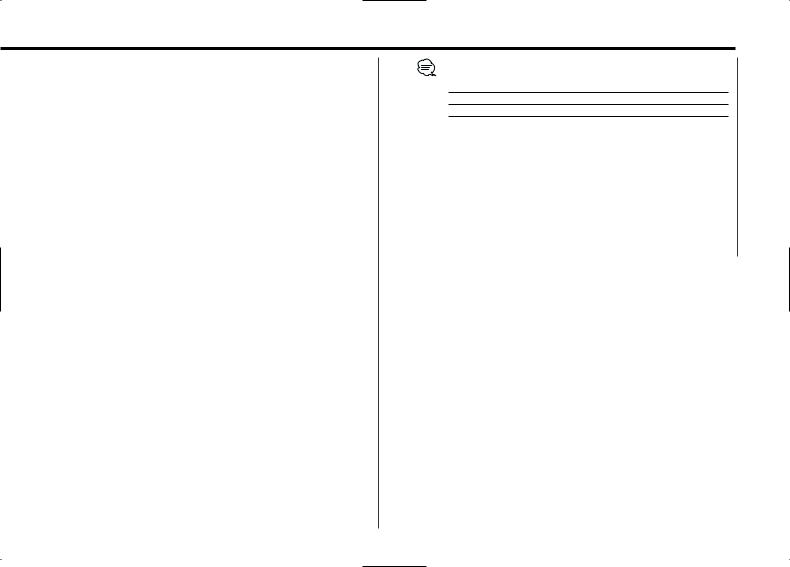
3Select the Audio item for adjustment
Press the [FM] or [AM] button.
Each time the button is pressed the items that can be adjusted switch as shown below.
4Adjust the Audio item
Press the [4] or [¢] button.
Adjustment Item |
Display |
Range |
Bass Center |
"Bass FRQ" |
60/70/80/100 or 150 Hz |
Frequency |
|
|
Bass level |
"Bass" |
–8 — +8 |
Bass Q Factor |
"Bass Q" |
1.00/1.25/1.50/2.00 |
Bass Extend |
"Bass EXT" |
ON/OFF |
Middle Center |
"MID FRQ" |
0.5/1.0/1.5/2.0 kHz |
Frequency |
|
|
Middle level |
"MID" |
–8 — +8 |
Middle Q Factor |
"Middle Q" |
1.0/2.0 |
Treble Center |
"TRE FRQ" |
10.0/12.5/15.0/17.5 kHz |
Frequency |
|
|
Treble level |
"TRE" |
–8 — +8 |
Balance |
"Balance" |
Left 15 — Right 15 |
Fader |
"Fader" |
Rear 15 — Front 15 |
Non-Fading level |
"NF Level" |
–15 — +15 |
Front High Pass Filter "HPF Front" |
Through/40/60/80/100/120/ |
|
|
|
150/180/220 Hz |
Rear High Pass Filter |
"HPF Rear" |
Through/40/60/80/100/120/ |
|
|
150/180/220 Hz |
Non-Fading |
"LPF NF" |
50/80/120/Through Hz |
Low Pass Filter |
|
|
Non-Fading Phase |
"NF Phase" |
Normal (0°)/Reverse (180°) |
Volume offset |
"Volume Offset" –8 — ±0 |
|
Loudness |
"LOUD" |
ON/OFF |
•According to the Bass Q Factor setting value, the frequencies that can be set in Bass Center Frequency change as shown below.
Bass Q Factor |
Bass Center Frequency |
1.00/1.25/1.50 |
60/70/80/100 |
2.00 |
60/70/80/150 |
•When the bass extend is set to ON, low frequency response is extended by 20%.
•Volume offset: Each source's volume can be set as a difference
from the basic volume.
• Loudness: Compensating for low and high tones during low volume.
(KDC-MP919/X759) The graphic is displayed when Loudness is ON, and is switched OFF when Loudness is OFF.
5Exit Audio Control mode
Press the [AUD] button.
— 11 —
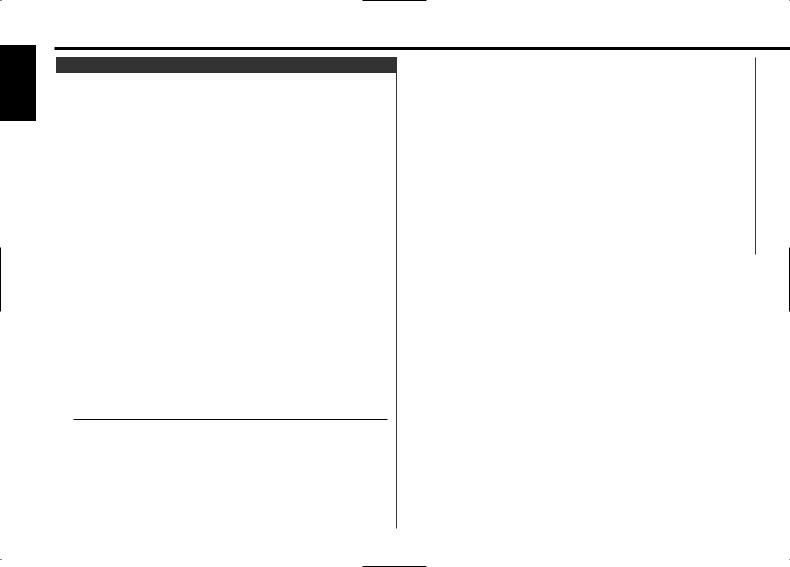
English
General features
Speaker & Woofer Setting
Speaker setting allows the System Q settings to be fine-tuned according to the type of speakers.
Woofer setting allows for Network configuration according to the type of subwoofers.
1Enter Standby
Press the [SRC] button.
Select the "ALL OFF" display.
2Enter Speaker & Woofer Setting mode
Press the [Q] button.
"Speaker Setting" is displayed.
3Select the Setting mode
Press the [FM] or [AM] button.
Each time the button is pressed it switches between Speaker setting mode and Woofer setting mode.
4Select the Speaker and Woofer type
Press the [4] or [¢] button.
Each time the button is pressed the setting switches as shown below.
In Speaker setting mode |
|
||
|
Speaker type |
Display |
|
|
OFF |
|
"OFF" |
|
For 5 |
& 4 in. speaker |
"5/4inch" |
|
For 6 |
& 6x9 in. speaker |
"6*9/6inch" |
|
|
|
|
|
For the OEM speaker |
"O.E.M." |
|
In Woofer setting mode |
|
|
|
Woofer type |
Display |
|
OFF |
"Woofer OFF" |
|
12 in. A type |
"12in type A" |
|
10 in. A type |
"10in type A" |
|
12 in. B type |
"12in type B" |
|
10 in. B type |
"10in type B" |
|
12 in. C type |
"12in type C" |
|
10 in. C type |
"10in type C" |
|
8 in. type |
"8inch" |
|
12 in. D type |
"12in type D" |
|
10 in. D type |
"10in type D" |
5Exit Speaker & Woofer Setting mode
Press the [Q] button.
— 12 —

Switching Full Screen Display
Switching the Full screen display.
1Enter Menu mode
Press the [MENU] button for at least 1 second.
"MENU" is displayed.
2Select Display Control mode
Press the [FM] or [AM] button.
Select the "Display Mode Select"/"Disp Mode Select" display.
3Enter Display Control mode
Press the [4] or [¢] button for at least 1 second.
4Switch the Full screen display
Press the [4] or [¢] button.
Each time the button is pressed the display switches.
Information
Demonstration Spectrum Analyzer 1 Spectrum Analyzer 2 Spectrum Analyzer 3
Graphic 1 (KDC-MP919/ X759) Spectrum Analyzer 4 (KDC-X859) Graphic 2 (KDC-MP919/ X759) Spectrum Analyzer 5 (KDC-X859)
5Exit Display Control mode
Press the [MENU] button.
Full Screen display can be selected when "Display Type C" is selected in <Switching Display Type> (page 32).
Switching the Standby Display
Switching the information displayed in Standby.
1Enter Standby
Press the [SRC] button.
Select the "ALL OFF" display.
2Enter Menu mode
Press the [MENU] button for at least 1 second.
"MENU" is displayed.
3Select Display Control mode
Press the [FM] or [AM] button.
Select the "Display Mode Select"/"Disp Mode Select" display.
4Enter Display Control mode
Press the [4] or [¢] button for at least 1 second.
5Switch the display
Press the [4] or [¢] button.
Each time the button is pressed the display switches.
Information |
Display |
Demonstration |
"DEMONSTRATION" |
Date & Clock |
"DATE"/"CLOCK" |
Standby display |
"ALL OFF" |
6Exit Display Control mode
Press the [MENU] button.
Demonstration can be selected when "Display Type A" or "Display Type C" is selected in <Switching Display Type> (page 32).
— 13 —
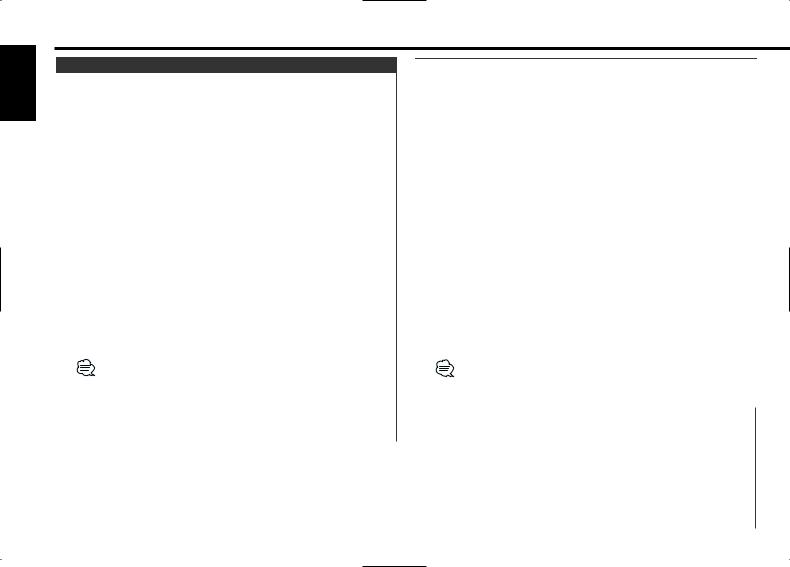
English
General features
Switching Upper and Lower Part Display
Switching the upper and lower part display.
1Enter Menu mode
Press the [MENU] button for at least 1 second.
"MENU" is displayed.
2Select Display Control mode
Press the [FM] or [AM] button.
Select the "Display Mode Select"/"Disp Mode Select" display.
3Enter Display Control mode
Press the [4] or [¢] button for at least 1 second.
4Switch the Upper part display
Press the [FM] or [AM] button.
Switch the Lower part display
Press the [4] or [¢] button.
Each time the button is pressed the display switches.
The Reference for the display content is after this operation's explanation.
5Exit Display Control mode
Press the [MENU] button.
•The same information can't be displayed on the Upper part display and lower part display.
•The Upper part display and Lower part display switching can be selected when "Display Type A" is selected in <Switching Display Type> (page 32).
•When "Display Type B" is selected the Lower part display content is clock ON or OFF.
In Tuner source |
|
|
|
|
Upper Part Display |
|
|
|
|
|
Information |
|
Display |
|
|
Station name or Frequency |
|
"BAND+ch+SNPS" |
|
|
or |
|
|
|
|
Program Service name or Frequency |
|
"BAND+ch+PS" |
|
|
(KDC-X859 only) |
|
|
|
|
Radio text (KDC-X859 only) |
|
"R-TEXT" |
|
|
Frequency |
|
"BAND+ch+FREQ" |
|
Lower Part Display |
|
|
|
|
|
Information |
|
Display |
|
|
Spectrum Analyzer (KDC-MP919/ X759) |
"S/ANA" |
|
|
|
Spectrum Analyzer & Graphic (KDC-X859) |
"S/ANA+GRAPHIC" |
|
|
|
Spectrum Analyzer & Clock (KDC-X859 only) |
"S/ANA+CLOCK" |
|
|
|
Spectrum Analyzer (KDC-X859 only) |
|
"S/ANA" |
|
|
Radio text (KDC-X859 only) |
|
"R-TEXT" |
|
|
Date |
|
"DATE" |
|
|
Spectrum Analyzer & Clock |
|
"S/ANA+CLOCK" |
|
|
(KDC-MP919/ X759) |
|
|
|
|
Clock & Graphic (KDC-X859) |
|
"CLOCK+GRAPHIC" |
|
|
For Station name registration refer to <Station/Disc Naming |
|
||
|
(SNPS/DNPS)> (page 16). |
|
|
|
|
|
|
|
|
In CD/ External disc source |
|
|
|
|
Upper Part Display |
|
|
|
|
|
Information |
Display |
|
|
Track Time |
"P-Time" |
Disc name |
"DNPS" |
Disc title |
"DISC-TITLE" |
Track title |
"TRACK-TITLE" |
— 14 —

Lower Part Display |
|
|
|
|
|
||
|
Information |
Display |
|
|
Spectrum Analyzer |
"S/ANA" |
|
|
(KDC-MP919/ X759) |
|
|
|
Spectrum Analyzer & Graphic |
"S/ANA+GRAPHIC" |
|
|
(KDC-X859) |
|
|
|
Spectrum Analyzer & Clock |
"S/ANA+CLOCK" |
|
|
(KDC-X859 only) |
|
|
|
Spectrum Analyzer |
"S/ANA" |
|
|
(KDC-X859 only) |
|
|
|
Track Title |
"TRACK-TITLE" |
|
|
Disc Title |
"DISC-TITLE" |
|
|
Disc name |
"DNPS" |
|
|
Date |
"DATE" |
|
|
Spectrum Analyzer & Clock |
"S/ANA+CLOCK" |
|
|
(KDC-MP919/ X759) |
|
|
|
Graphic & Clock (KDC-X859) |
"CLOCK+GRAPHIC" |
|
|
For Disc name registration refer to <Station/Disc Naming |
||
|
(SNPS/DNPS )> (page 16). |
|
|
|
Function of the KDC-X859/KDC-MP919 |
||
|
|
|
|
In MP3 source |
|
|
|
Upper Part Display |
|
|
|
|
Information |
Display |
|
|
Track Time |
"P-Time" |
|
|
Disc name |
"DNPS" |
|
|
Folder name |
"FOLDER NAME" |
|
|
File name |
"FILE NAME" |
|
|
Song title & Artist name |
"TITLE/ARTIST" |
|
|
Album name & Artist name |
"ALBUM/ARTIST" |
|
|
|
|
|
Lower Part Display |
|
|
|
Information |
Display |
|
Spectrum Analyzer (KDC-MP919) |
"S/ANA" |
|
Spectrum Analyzer & Graphic (KDC-X859) |
"S/ANA+GRAPHIC" |
|
Spectrum Analyzer & Clock (KDC-X859 only) |
"S/ANA+CLOCK" |
|
Spectrum Analyzer (KDC-X859 only) |
"S/ANA" |
|
Album name & Artist name |
"ALBUM/ARTIST" |
|
Song title & Artist name |
"TITLE/ARTIST" |
|
File name |
"FILE NAME" |
|
Folder name |
"FOLDER NAME" |
|
Disc name |
"DNPS" |
|
Date |
"DATE" |
|
Spectrum Analyzer & Clock (KDC-MP919) |
"S/ANA+CLOCK" |
|
Clock & Graphic (KDC-X859) |
"CLOCK+GRAPHIC" |
For Disc name registration refer to <Station/Disc Naming (SNPS/DNPS)> (page 16).
In Auxiliary input source |
|
|
Lower Part Display |
|
|
|
Information |
Display |
|
Spectrum Analyzer (KDC-MP919/ X759) |
"S/ANA" |
|
Spectrum Analyzer & Graphic (KDC-X859) |
"S/ANA+GRAPHIC" |
|
Spectrum Analyzer & Clock (KDC-X859 only) |
"S/ANA+CLOCK" |
|
Spectrum Analyzer (KDC-X859 only) |
"S/ANA" |
|
Album name & Artist name |
"ALBUM/ARTIST" |
|
Date |
"DATE" |
|
Spectrum Analyzer & Clock |
"S/ANA+CLOCK" |
|
(KDC-MP919/ X759) |
|
|
Graphic & Clock (KDC-X859) |
"CLOCK+GRAPHIC" |
The Auxiliary input name is always displayed on the Upper part display.
— 15 —
